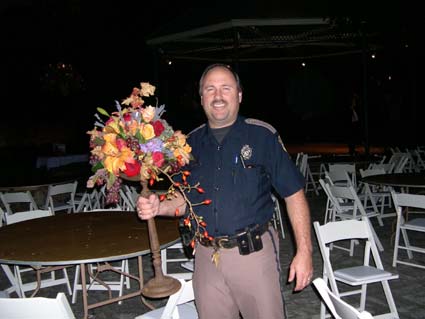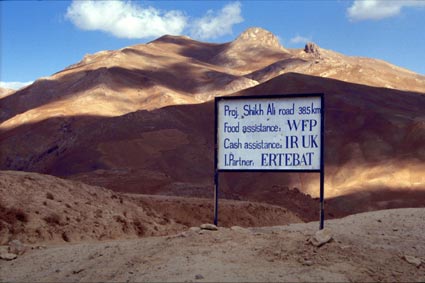2004
Turner
Prize
leaves
us
voiceless,
with
a
strong
desire
to
come
back
for the
next
awards

Jeremy Deller, "Cop with Flowers", San Antonio, Texas 2003
Courtesy of the Modern Institute, Glasgow © the artist
Jeremy Deller, the 2004 winner "acts as a catalyst for boarder ranger projects... He pays attention to things happening to the fringe off the mainstream";
At the entrance of the exhibition, on a huge white wall, he wrote like a student taking notes during a boring course, almost at random, following a strange idea path, hundred of words as to depict a complex system, linking social groups and apparently opposed worlds. "Acid House", "Brass Bands", "Ibiza", "Psychics", taken from the 70's under Kraftwerk influence, up to "Advanced Capitalism", through "route 66 or 208…"
Books on hand for everyone, a diverse knowledge to share, "life of Brian Epstein", The Beatles manager dead very young, "9/11 commission", hour by hour, minute by minute, second by second, "The Texas portable handbook",
A medley of ideas which seem to want to take us to a dramatic understanding of U.S. – IRAK disaster, but depicted by little impressionist touches nothing is imposed, everything is suggested. If his position is strong, it is our part to say "NO", the artist deliberately remains light and soft.
Even in its master piece the documentary done in Texas, "Memory Bucket", nothing brutal, but a cohabitation of people and says which lets us think and think again…
The sole violent vision of his performance is allusive: The last image, with hundreds bats flying loudly in a sunset leaves a strange bitter after taste, allusion to Hitchcock's birds, or to Nosferatu , horror is coming soon, go and protect yourself.

Kutlug Ataman, Still from Women Who Wear Wigs 1999
Courtesy the artist and Lehmann Maupin Gallery, New York
Kutlug Ataman, change of vision, change of perspective, we now touch border worlds, souls, death and rebirth, conscience and life. Six persons of all ages speak slowly and peacefully about their death and rebirth, as an evidence, as a peaceful fact which makes their life different, deep and full of confidence.
Sober testimonies and close up videos, no special effects, focus on words and eyes,
sameness of tones, and scenography make it hard to identify each testimony from the other, organised as to be intricate like different parts of a same story, a universal story, like "drops in the sea". With simple statements:
"The soul is the secret of God"
"You can only talk about what you feel",
"Lord erases the knowledge from your mind; he doesn't let you carry it into this world"
Strangely too, the position of the screens permits visitors to walk between the screens and the projector, creating therefore strange human shadows on the images. Like silent phantoms.
We have here a weird sensation of dialogues with oneself, monologues, not really intended to be shared, amplified by the depth of all these eyes, both intense, and merged into a next world which they know as their own world.
These works only require our attentive listening, our absence of judgment, our time to absorb another vision of life.

Langlands & Bells, Still from NGO 2003
Courtesy of the artists and the Trustees of the Imperial War Museum
Langlands & Bells take us to light, sober, suggestive visions, here too, nothing is imposed; "They explore the web linking people, architecture, and code systems of circulation and exchange that surround us".
The exhibition starts with a sparkling neon quadrant of the abbreviated names of main world's airports. LAX, CDG, LDN, and some flags, with abbreviated name of NGO. Logos but no words, only signs.
Letters mask realities, they have a nice, aesthetical, advertising like design look, they are built to reassure; they gather people behind a pure idea or concept.
A loud haunting never ending Islamic prayer fills the space. We shall later discover that this is the blessing prayer recorded on the trial of oct 15th 2002, at the supreme Court in Kaboul. The unique emotion of this interesting but cold performance.
After tens of logos, in all sizes, elegantly photographed, Ussama Ben Laden's home comes into a virtual video game, where we are supposed to play, to act as a warrior, visiting a place destroyed by the bombs. And close to this, a series of slides, images of war, bunkers, ruins, helicopters, villages, almost no life, only facts, but hard facts.
Impartial vision of a non implicated artist, too much aesthetic, too much brain, no heart and soul are allowed, too bad.
Laconic piece of information… "A part of the installation currently in progress has been removed as not interfere with the trial of Faryadi Sarwar Zardal". No more comments.

Yinka Shonibare, Still from Un Ballo in Maschera (A Masked Ball), 2004,
Commissioned for the Moderna Museet, Stockholm.
Produced by Moderna Museet and Sveriges Television.
Courtesy Stephen Friedman Gallery, London
Yinka Shonibare, My favourite artist of this exhibition The so-called African Dandy, expresses sensuality, energy, humour, instinct, sophistication, mystery, and joy, under a profound influence of his native country. This is the stunning part of the Prize which explodes and captivates us. "I wanted to produce something which is much more exciting and playful, and I do that with a broad smile." His work is to surprise and inspire, to leave speechless, or to prompt, to comprise while at the same time enlighten the ambivalence of the near oxymoron". He produces a seductive and destabilizing work. in which there are issues of taste involved, and issues of class . He likes taking a middle-class item, a Dutch wax fabric bought from an African market and making it into a "high art" that sells for a lot of money.
The performance starts with a work after Fragonard, a decadent and joyful version of "the swing": a life-size headless mannequin, (humoristic aperću to the French revolution), expressing pure desire, seduction, and lust for life. Dressed in a XVIII century costume made of Dutch wax printed cotton, with the double C of Chanel's logo, it reveals a great deal of energy and lightness.
Then, a complete wall shows 74 circular canvasses, in different sizes, all made of a mixture of painting and wax fabric. A stunning and vivid composition organised as a playful area, like a broad smile, evoking pure freedom in term of pleasure rhythm and colour.
His third work is more complex: A 20 minutes ballet about the assassination of the Swedish king Gustav III in 1792, at a masked ball. A fascinating very slow and silent choreography. One can only hear the sound of the steps on the wooden floor, the breath of the dancers, the soft rubbing of the costumes on each other, the claps of the hands, like percussive noises.
The king is an androgynous character, who dies and rises again from his ashes, like a Phoenix. This performance left me floating between different worlds, Comedia del Arte, mime, and African queens…
Edith Lassiat
London, december 2004